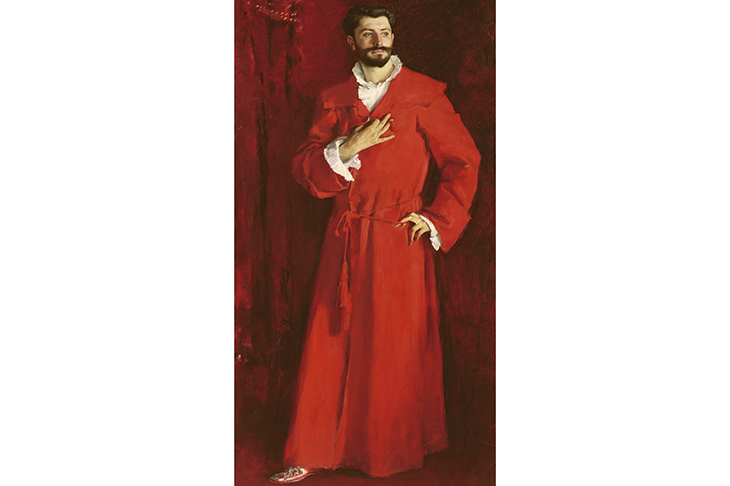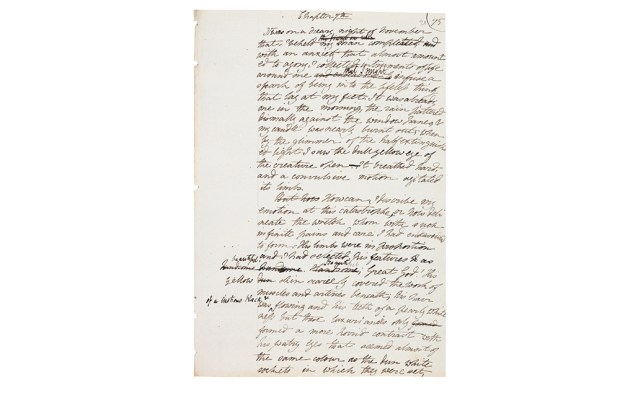Do not google Samuel Jean Pozzi. If you want to enjoy Julian Barnes’s The Man in the Red Coat — and believe me, it’s teeming with delights — stay away from search engines and trust the author to tell the story in his own way.
But just to get you started: Pozzi (1846–1918), the man John Singer Sargent painted, gloriously, in sumptuous red, was a Frenchman, a prominent, pioneering doctor in Belle Epoque Paris, and a charming, ubiquitous, infallibly seductive socialite. (‘Disgustingly handsome’ is how the Princess of Monaco described him.) He was Sarah Bernhardt’s doctor and also her lover; she called him ‘Docteur Dieu’. (His other nickname was ‘L’Amour médecin’, which Barnes translates as Dr Love.)
In the introduction to his ground-breaking two-volume treatise on gynaecology, Pozzi wrote: ‘Chauvinism is one of the forms of ignorance.’ In his inaugural lecture as the first professor of gynaecology in all of France he declared that ‘conscience must be the first characteristic of a doctor, especially one who wields a knife’. He had his human failings: he was not a good husband to his rich wife, and also a flop as a father to his unhappy, high-minded, highly strung daughter. And yet — enlightened, amusing, engaged and engaging, this Docteur Dieu is an undiscovered hero.
If that’s not enough to grab you, here’s Barnes’s hook: in June 1885, Pozzi accompanied Prince Edmond de Polignac and Count Robert de Montesquiou on a trip to London for what Montesquiou described as some ‘intellectual and decorative shopping’.The trio arrived in town armed with a letter of introduction from Sargent addressed to Henry James. The great novelist steered his French visitors from concert hall to gallery to bookshop (and to Liberty’s and to Bond Street tailors). They met Burne-Jones, Rossetti, Alma-Tadema and Whistler.
Who were Pozzi’s aristocratic pals? Polignac was a musician, a gentle, retiring soul, sweet and consequently somewhat less interesting than the others. He plays a relatively minor part in the story, serving chiefly to illustrate a Jamesian theme: dead broke European nobility marrying vastly rich American heiresses, in this case Winnaretta Singer (think Singer sewing machines). It was a happy match. ‘Polignac all his life had been a discreet but known homosexual,’ Barnes writes. ‘Yet far from being an impediment, this proved to be his unique selling point, because Singer, in her turn, was a discreet but known lesbian.’
Montesquiou was a poet and a dandy. Proust, who admired him, called him ‘the Professor of Beauty’; Sargent called him ‘unique and extra-human’. A deliciously displeasing individual, he combined, in a toxic yet alluring blend, arrogance, snobbery, ruthlessness, wit and style. His name is inextricably linked with a fictional character: Des Esseintes, the protagonist of Huysmans’s A Rebours. After reading the novel on his honeymoon in Paris in 1884, the year it was published, Oscar Wilde called it ‘one of the best I’ve ever seen’. If A Rebours is a guidebook to decadence, Montesquiou is its Mecca.
The icing on this high-culture confection: Proust pilfered bits of all three of the French tourists and turned them (‘partially, refractedly’) into characters in À la recherche du temps perdu.
Why didn’t Barnes do the same? He could have made Samuel Pozzi the protagonist of a spectacular historical novel, just as 15 years ago he borrowed Arthur Conan Doyle and George Edalji for his copiously researched Arthur & George. Or he could have stitched a whole spool of verified fact about Pozzi into a wider fictional tapestry, as he did 35 years ago with Flaubert in Flaubert’s Parrot.
But no. Barnes has chosen to produce a scrupulously non-fictional portrait of Pozzi, a life-and-times biography dismantled and disordered. It’s a modernist approach —you could call it Cubist if you wanted to get cute. Crowded with colourful Belle Epoque characters, the narrative meanders here and there, cheerfully digressing. Barnes himself pops up occasionally to comment on his own methods — saying, for instance about the loathsome journalist Jean Lorraine: ‘He is someone you half want to keep out of your book, for fear he might take over too much of it.’ Barnes as tour guide is humorous, occasionally crotchety and always prudishly sceptical.
A characteristic sentence:
Everyone knows—or rather ‘everyone knows’ — that Count Robert de Montesquiou owned a pet tortoise, whose shell was painted gold and studded with precious stones.
The scare quotes separate Barnes’s project from Huysmans’s: in A Rebours, Des Esseintes had such a pet; Montesquiou, in ‘real life,’ perhaps not. ‘Part of the novelist’s job,’ Barnes explains, ‘is to turn a slight, even false rumour into a glitteringly certain reality.’ Part of the biographer’s job is to separate what we know from what we don’t. ‘We cannot know,’ Barnes writes, ‘but we can certainly doubt.’ He insists on this: ‘We cannot know’ becomes his proud refrain, first deployed with regard to the genesis and duration of the Pozzi-Bernhardt affair. Later he explains that it is ‘one of the strongest phrases in the biographer’s language’:
It reminds us that the suave study-of-a-life we are reading, for all its detail, length and footnotes, for all its factual certainties and confident hypotheses, can only be a public version of a public life, and a partial version of a private life. Biography is a collection of holes tied together with string, and nowhere more so than with the sexual and amatory life.
Barnes wants to do justice to Pozzi, to spare him both the glittering certainties of fiction and the pompous, false authority of conventional biography. (The clever line about biography being a collection of holes is recycled material, originally from Flaubert’s Parrot.)
But what is it about Samuel Pozzi that he requires such super-sanitised treatment? (He was an early and ardent champion, by the way, of Joseph Lister’s antiseptic procedures.) Barnes tells us that one of the first things he read about Pozzi was that Docteur Dieu was ‘not only the father of French gynaecology but also a confirmed sex addict who routinely attempted to seduce his female patients’. This casual smear clearly outraged Barnes, who is nonetheless cautious and open-minded — ‘we cannot know’ — in defence of his hero. He points out that there is not ‘a single recorded note of female complaint’ against Pozzi, and hardly a whisper of gossip in a time and place where scandal was a major spectator sport.
Barnes wisely observes that this silence could be ‘just another aspect of the way male power played out’. Calmly, though, and convincingly, he argues that Pozzi’s (many?) affairs were consensual — that he was not a ‘ruthless libertine’, let alone a ‘sex addict’. The accusation, he concludes, can only stem from ‘a 21st-century coarsening of language and memory’.
The Man in the Red Coat has larger ambitions than the defence of Pozzi’s ‘sexual and amatory life’. Barnes keeps a sharp eye on the ways in which art and life interact, a mimetic ebb and flow nowhere near as predictable as the tides. Weighing up the differences between the French and the English is an old Barnes habit which Brexit (‘Britain’s deluded, masochistic departure from the European Union’) won’t break. So is musing on past and present, and the distortions involved in looking forward or back — or even into the mirror. ‘No one in Paris,’ he writes, ‘ever said to one another, in 1895 or 1900, “We’re living in the Belle Epoque, better make the most of it.”’
Barnes has great fun introducing us to Pozzi’s sophisticated world, and letting his extravagant cast of dandies, aesthetes, and artists prance across the stage, but he doesn’t neglect the darker side. It was, he tells us, ‘an age of neurotic, even hysterical national anxiety’; the book is punctuated by the sound of gunshot — senseless duels and cold-blooded assassinations.
In Levels of Life (2013), another brilliant, defiantly unconventional book, Barnes issued a mini manifesto: ‘Writers believe in the patterns their words make, which they hope and trust add up to ideas, to stories, to truths.’ The truth he’s aiming at here, which emerges gradually from the artful jumble of anecdote and digression, is Flaubertian. Accurate description performs a corrective function by showing us how things truly are — and aren’t. Here is Samuel Pozzi, says Barnes — an extraordinary, though not ‘extra-human’, Frenchman who died more than 100 years ago after living an implausibly rich and worthy life. There is of course much we cannot know — but here he is.
Got something to add? Join the discussion and comment below.
Get 10 issues for just $10
Subscribe to The Spectator Australia today for the next 10 magazine issues, plus full online access, for just $10.
You might disagree with half of it, but you’ll enjoy reading all of it. Try your first month for free, then just $2 a week for the remainder of your first year.














Comments
Don't miss out
Join the conversation with other Spectator Australia readers. Subscribe to leave a comment.
SUBSCRIBEAlready a subscriber? Log in